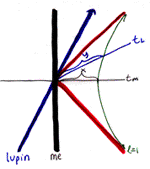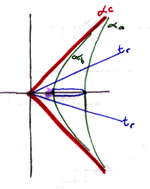




Jillian's Guide to Black Holes: Forming - Types - Outside - Inside - Finding - References - Websites
New Tools for Dealing with Accelerated Objects
 It's a little trickier. You will have to take my word that most of this is true, because it involves some math that I'd rather not show here. To the left is just a spacetime diagram of Lupin coming up behind me, flying over my shoulder, and flying away in front of me. That green parabola is a line of constant distance. See Lupin's line of simultaneity? See mine? X and Y trace out the same proper distance, for that's where our lines of simultaneity cross the parabola.
It's a little trickier. You will have to take my word that most of this is true, because it involves some math that I'd rather not show here. To the left is just a spacetime diagram of Lupin coming up behind me, flying over my shoulder, and flying away in front of me. That green parabola is a line of constant distance. See Lupin's line of simultaneity? See mine? X and Y trace out the same proper distance, for that's where our lines of simultaneity cross the parabola.
If someone else were moving faster than Lupin, their line of simultaneity would cross the parabola above Y and would trace out an even longer distance. This has to do with something called length contraction. Length contraction is a lot like time dilation. The faster someone moves, the shorter they seem to an inertial observer. Likewise, the faster someone moves, the shorter the inertial observer seems to them. A line (parabola, really) of constant time is the same green line rotated 90° counter-clockwise.
Drawing Diagrams for Accelerated Objects
 Aha, now I can show you what a spacetime diagram of an accelerated object---in this case a spaceship. Again, those green parabolas are lines of constant distance. One is the front of the rocket, and one is the back end. You'll notice that the parabolas have different, well...curvature, for lack of a better word. The parabola at the front is less curved than the one at the back. What does this mean? This means that the front of the rocket experiences less acceleration than the back. The closer the parabola gets to looking like the light rays, the more acceleration that object experiences. Material things cannot have a parabola that exactly follows the light ray---that would mean they have infinite acceleration and are going at the speed of light (which matter just can't do).
Aha, now I can show you what a spacetime diagram of an accelerated object---in this case a spaceship. Again, those green parabolas are lines of constant distance. One is the front of the rocket, and one is the back end. You'll notice that the parabolas have different, well...curvature, for lack of a better word. The parabola at the front is less curved than the one at the back. What does this mean? This means that the front of the rocket experiences less acceleration than the back. The closer the parabola gets to looking like the light rays, the more acceleration that object experiences. Material things cannot have a parabola that exactly follows the light ray---that would mean they have infinite acceleration and are going at the speed of light (which matter just can't do).
What about simultaneity?
Previously, you saw that two different observers had different lines of simultaneity. Does that mean that the front of the rocket would describe different events as simultaneous than the back? Nopers! See that top blue line? That's the line of simultaneity for both front and back! What's the catch? There's gotta be a catch. While both ends agree about what events are simultaneous, they do not agree about the time said events happened. Someone at the back end would think the person at the front end has a fast watch, and someone at the front would complain the person at the back has a slow watch. Granted, these effects are miniscule in most situations. The disparity between the two watches is only significant when the difference in acceleration is large. Spaceships are certainly not large enough for that!


